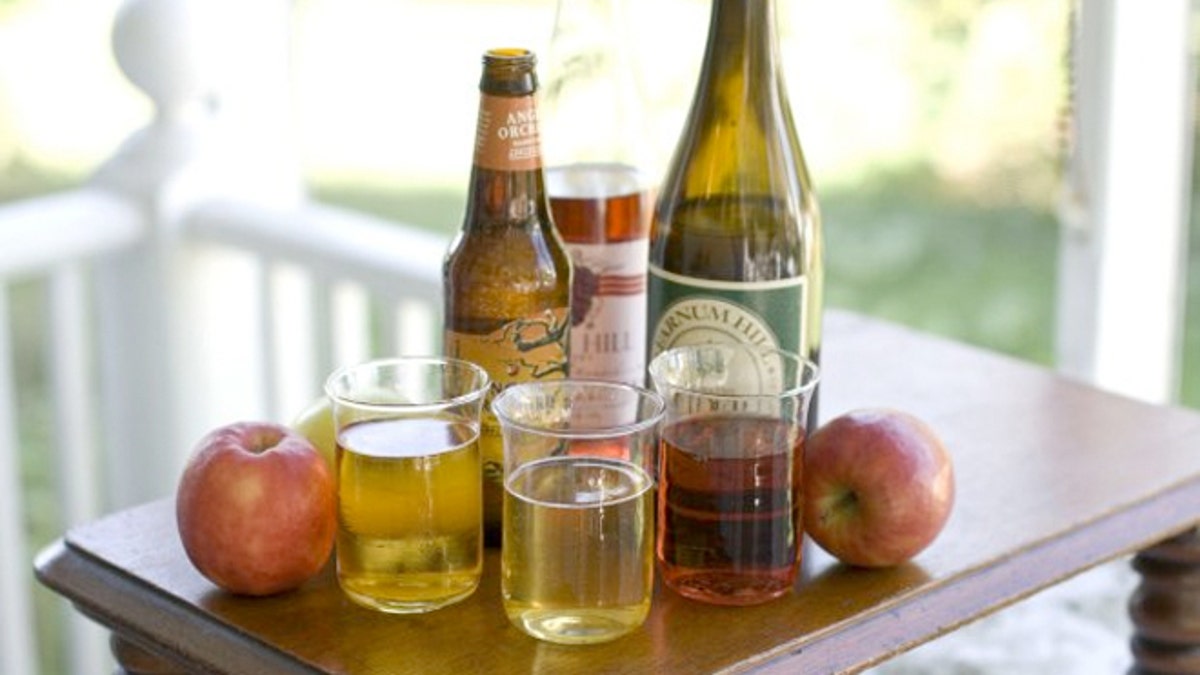
Hard cider still is a small part of the overall alcoholic beverage market, but it is a rapidly growing niche. (AP)
Autumn's a great time to fall for apple appeal, with cooler temperatures setting the stage for the fruit to star in gently steaming pies and alongside fragrant roasts.
Or, you could drink your apple a day, the fermented way.
Hard cider, which came to the United States with the pilgrims but was lost in a sea of sweet, unfermented juice after Prohibition, has been making a comeback with increased sales and launches of new styles and flavors that have brought a bushel of options to store shelves.
"It's the most exciting beverage category in the market," says Jeffrey House, founder of the California Cider Co., the Sebastopol, Calif., based company that produces ACE Premium Hard Ciders, a major player among domestic producers.
Hard cider still is a small part of the overall alcoholic beverage market; sales don't come close to the multibillion-dollar beer industry. But it is a rapidly growing niche.
According to data from Chicago-based market research firm SymphonyIRI Group, hard cider sales at supermarkets and other stores (data exclude Walmart, club stores and liquor stores) totaled about $71.5 million for the 52 weeks ending Aug. 5, more than a 50 percent increase over the same period a year before.
More sales means more products. Anheuser-Busch has a cider out, Michelob Ultra Light Cider. And Boston Beer Co., makers of Samuel Adams, this spring introduced three varieties of Angry Orchard cider —Crisp, which is a little sweeter, Apple Ginger, and Traditional Dry, a mellow, slightly tangy drink in the style of an English draught cider.
To get the cider right, Angry Orchard cider maker David Sipes and his team traveled around the world studying cider making and sourcing apples, getting their fruit from Europe, including Northern Italy. "We found just some fantastic apple varieties really well-suited for cider production," he says. They also use traditional cider apples — bittersweet fruit that isn't very tasty raw — from Normandy and Brittany in France.
"A lot of the same things a winemaker would be looking for in their grapes we're looking for in cider apples. We're looking for certain balance of tannin and acidity and Brix (sugar levels) and the cider apples really lend a lot of those characteristics," he said. "The end result is just a cider of really uncommon complexity."
The attention to detail includes aging some of the ciders with wood; oak staves or chips are put into the tanks to add a subtle touch of the vanilla and baking spices that come with oak aging.
And just like wine, cider pairs well with food, says Sipes, who compares the Traditional Dry cider to a sauvignon blanc or unoaked chardonnay. "We're finding so many opportunities for pairing with foods."
All this marks a major change in the market. As recently as 10 to 15 years ago, American consumers were lucky to find one or two lackluster national brands. These days they can choose between numerous premium options, with some bars even offering it on tap.
House, a native of England, where hard cider has a long tradition (in fact, it's known there as cider, anything else is just apple juice), started out in the United States 25 years ago selling Blackthorn Cider and also sold British and Belgian beers. In 1994 he decided to form his own company, starting in Sonoma County.
Cider is made by pressing apples for the juice — House uses dessert apples — adding yeast, then allowing the juice to ferment. As with wine, the yeast consumes the sugar in the juice and turns it into alcohol. But not a lot of alcohol. Hard cider can range from 4 percent to 12 percent alcohol, but generally comes in at around 5 percent or 6 percent, comparable to the strength of beer (and half that of wine), but with a fruitier taste.
ACE styles range from dry to slightly sweeter, with one, the Joker, in a sparkling style that House compares to Champagne. For fall, the company is introducing ACE Pumpkin, which has a dash of cinnamon, ginger and other spices that go into pumpkin pie.
Cider's not the only adult beverage that can be made from apples. Distilling fermented apple juice creates a liquor that ranges from the classic French calvados to applejack, an American version that can be made through distillation or by concentration via freezing. Apple wine is another fermented product, but it is still, not sparkling, and generally has a higher alcohol level than cider.
One company is even combining its apple beverages. Among the half dozen cider varieties made by Dugspur, Va.-based Foggy Ridge Cider is Pippin Gold, a blend of hard cider and apple brandy. Whereas most ciders are consumed as one would a beer, Pippin Gold is considered more of a dessert cider or aperitif.
House made an apple brandy and aged it for five years in old red wine barrels. "It was brilliant," he says modestly. But cider is his priority. "That's our intention, to keep ACE as the premium cider in America ," he says. "Cider's really happening."